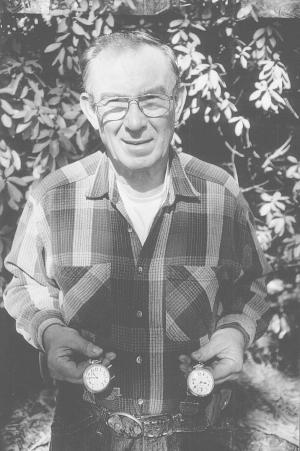2004 - Volume #28, Issue #1, Page #23
[ Sample Stories From This Issue | List of All Stories In This Issue | Print this story
| Read this issue]
A Walking Encyclopedia On Pocket Watches
 |
That's because he specializes in fixing and appraising American pocket watches, working for collectors and a number of jewelry stores around the country. The ones he possesses vary vastly in condition and quality, and he keeps most of them for parts.
Meyer is more than just a watch repairman. As a "watchmaker," he operates M&M Repair, and is both trained and skilled at such things as actually making certain parts like gears or stems.
"I don't know why people collect the things they do, but I know that watch collectors seem to specialize in one certain make or type of watch. Of course, they want the rarest ones in the best condition for whatever particular category they have chosen to focus on," Meyer says. "There are some pocket watches out there worth over $2,000, but they are few and far between. The average old farmer's common type jeweled pocket watch is worth anywhere between $100 and $200, depending on condition and age. The pin-lever type of pocket watch, commonly referred to as the dollar pocket watch, only ranges between $20 and $100."
Meyer says he probably has more American pocket watch parts than anyone in the U.S., given that two walls of his 8 by 14-ft. repair room are completely covered from top to bottom with cabinets full of parts.
"Very few people know the history of pocket watches as well as I do," he says.
According to Meyer, there have been about 15 different American pocket watch manufacturers, and each has made multitudes of types and styles. Some of the most prolific companies were: Elgins (April 1867-1956), Waltham (1851-1957), Hamilton (1892 û now, last American made one was in 1969), Illinois (1869 û1927 when bought out by Hamilton), Robert H. Ingersoll & Bros. (1892-1922 û bought out by Waterbury but continued to use Ingersoll name until 1944), New Haven Clock and Watch Co. (1853 û 1956), E. Ingraham Co. (1912 û 1968), and Westclox (1899 û now but last pocket watch made around 1990).
"I do a lot of research for people û all I need from them to go on is the make, and serial number off of the movement. The movement is the gears, etc. that make up the watch itself. The serial number off the case is useless since manufacturers sometimes interchanged cases," he explains. "With the serial number, I can find out what the model number and grade is, when the watch was made, how many were made and where they were made. I've drawn up a pocket watch collector's data sheet to provide people with a record of all the intricate detailed descriptions of their watches. Sometimes collectors offer me some of their surplus watches as partial payment of their bill, and occasionally, I accept."
Meyer says he probably owns more watches than most collectors, but most of his are average, run of the mill, common watches. He has a couple that are rare. One of those is a Grade 948 Hamilton, worth around $500. There were only 1,500 of them made.
Contact: FARM SHOW Followup, Merlin M. Meyer, 625 E. Foster Road, Orcutt, Calif. 93455 (ph 805 934-4453).

Click here to download page story appeared in.

Click here to read entire issue
To read the rest of this story, download this issue below or click here to register with your account number.




